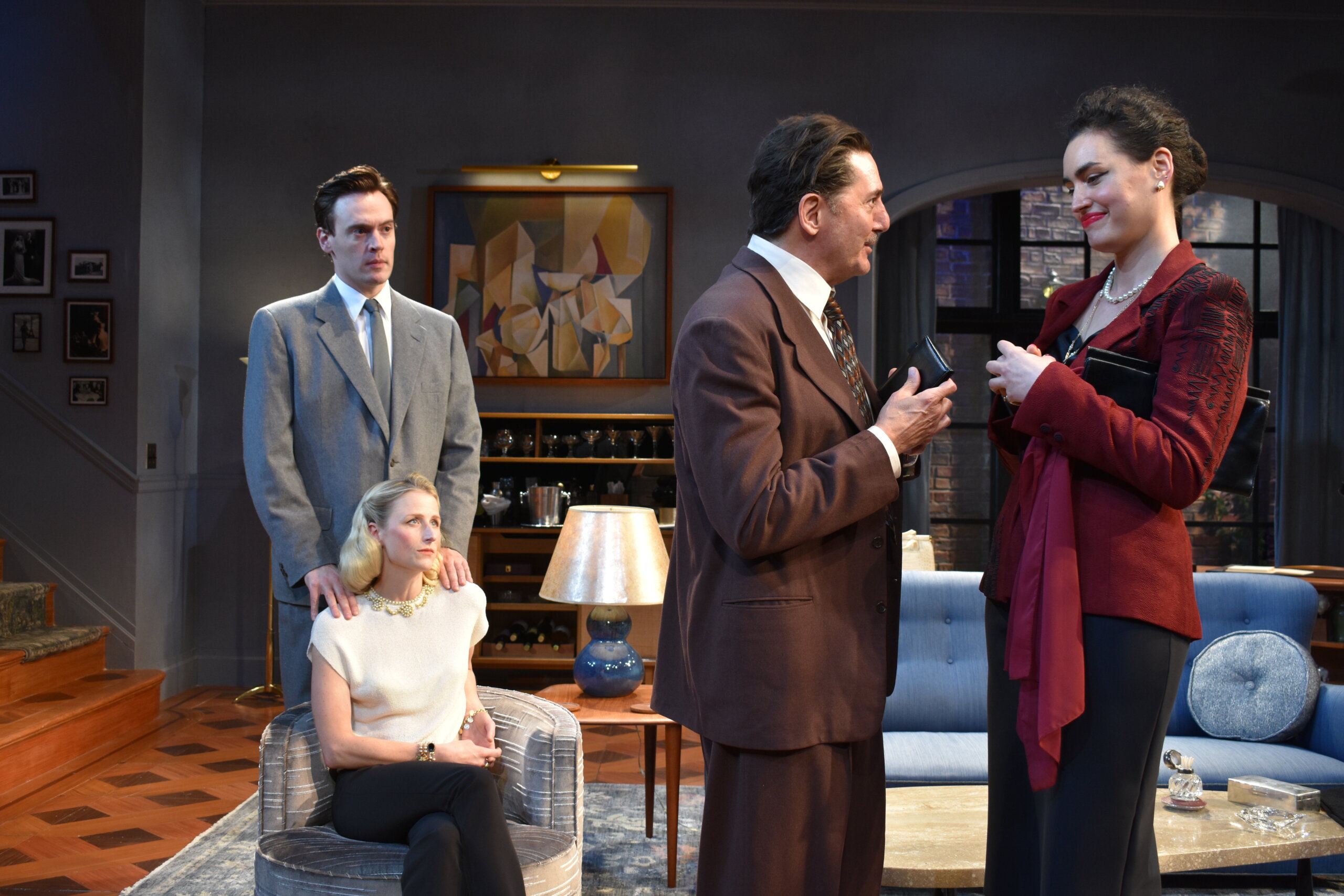Review: 'Dial M for Murder' at Bay Street Is Suspiciously Stunning

Bay Street Theater in Sag Harbor loves to keep its audience guessing. After the 2023 Mainstage season opened with a world-premiere musical, Double Helix, last week it debuted a fresh vision for the Frederick Knott play Dial M for Murder, made famous by the Alfred Hitchcock film. In Jeffrey Hatcher’s new adaptation, shocking twists, unexpected laughs and exhilarating performances make for a stunning thrill ride. In short, this new version is worth seeing before its final performance on Sunday, July 23, but if you’d like all the juicy details up front, beware spoilers ahead.
In a surprising evolution of the well-known Bay Street stage, audiences are greeted by a large curtain hiding the contents of the thrust stage. It would appear as if director Walter Bobbie envisioned the unveiling of the set as the first big reveal of the show. After two British coppers pull back the curtain, the audience is welcomed into the lavishly decorated London flat of the Wendices. Designed by Anna Louizos, this may be one of the theater’s most stylish sets to date, with midcentury pieces sourced from WYETH in Sagaponack.
Immediately in the first scene, those familiar with the source material will catch Hatcher’s biggest update to Dial M for Murder: Maxine Hadley. Renamed from Max to Mark Halliday when the 1952 play was adapted to film, Halliday’s character has been reworked further with the decision to make him a woman with a passion for murder mysteries. She’s set to debut her first mystery novel with the help of Tony Wendice, who’s in charge of the book’s marketing.
Their close collaboration makes the secret romance between Maxine and Margot Wendice, Tony’s wife, all the more dangerous, due to the 1950s setting, before homosexuality was officially decriminalized in the U.K.
The stakes are raised higher when Tony reveals to the audience his plan to have Margot murdered for her deception, but not out of jealousy. He had been waiting for a reason. In Hatcher’s adaptation, the Wendices’ marriage is a loveless sham on both sides. Tony has been after Margot’s bountiful inheritance from day one, and she was willing to settle for him to quell any rumors about her sexuality.
Maxine and Margot share a nuanced chemistry, where much of their banter could be translated as flirty or pass as stereotypical “girl talk,” but in the brief moments when their romance is unmistakable, it’s beautifully done. Tony and Margot’s relationship is equally complex.
While Tony is unequivocally psychopathic, constantly feigning emotions to manipulate others, his ruse is so effective that when Margot suspects that he or Maxine plotted to kill her, she ultimately sides with her husband.
Erich Bergen as Tony is brilliant casting. When Tony is in control of a situation, Bergen’s acting is suavely cunning and diabolical, but when backed into a corner, his calm, calculating nature becomes noticeably desperate and maniacal. Whenever his character is present, all eyes are on him. Even in scenes with no one but Bergen on stage, and no dialogue being spoken, he grasps the audience’s attention with every methodical, almost robotic movement.
Mamie Gummer is a delight as Margot, with each stage in the character’s descent into madness more fascinating to watch than the last. She starts off comparatively meek up against the sinister Tony and boisterous Maxine, and as events transpire, she becomes nervously attached to Tony and then goes full manic by the final scene.
Margot is easily the most endearing character in the production, helped by Gummer’s captivating and versatile performance.
Rosa Gilmore’s portrayal of Maxine is simply brilliant, boasting a commanding stage presence with charisma to spare. Keeping the audience on their toes as the most morally ambiguous of the main trio, Gilmore delivers lines spoken with unwavering conviction, proving her loyalty and love for Margot Wendice, then turns to do or say something suspicious or seemingly underhanded with equal levels of sincerity.
Also worth noting, although all characters were dressed expertly by Jeff Mahshie, Maxine’s glamorous style was stunning and helped her to stand out in every scene.
In addition to the main trio, each act of show has a fourth character who is central to the plot. In act one, there’s the conman of many names, played by Max Gordon Moore, who Tony entraps into becoming his reluctant assassin. He’s introduced as a sort of “poor man’s” reflection of Tony, sharing the same selfish agenda and devious tactics to accomplish it, but he pays the price for falling for the scams of a better conman.
Though his time onstage is short, Moore portrays this complicated, conflicted character with great skill, perhaps earning him a modicum of audience sympathy.
Finally, the scene-stealer of act two, is Reg Rogers as Inspector Hubbard. While there are a number of laughs throughout the show — none of which are in response to jokes in the traditional sense — Rogers easily receives the biggest and most frequent laughs for his quirky character. His eccentric manner of speaking and fixation on the Wendices’ taste in sculpture manage to keep the character lighthearted and fun despite his role as a gaslighting secondary antagonist.
Though this review contained spoilers for many of the updates to Dial M for Murder, there are still more to be experienced, all of which are amplified by smart lighting and sound design, and an effective piano accompaniment. And the ending, which differs from the Hitchcock film and will remain unspoiled here, is thoughtfully foreshadowed in the show, which makes it all the more exciting to sleuth out.
It’s no mystery whether or not Bay Steet has another must-see show on their hands with Dial M for Murder.
To purchase tickets, call 631-725-9500 or visit baystreet.org.



